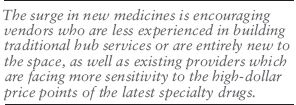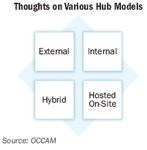Specialty Service Programs: Gearing up for Next Generation Technologies
Pharmaceutical Executive
Innovation in hub program design for patient scrip data and clinical support services can lead to increased market share in the hotly contested specialty medicine space.
The word from IBM: Innovation in hub hot line program design for patient scrip data and clinical support services can lead to increased market share in the hotly contested specialty medicine space.
What's the common thread that binds most successful specialty product launches? The answer is a well-designed information and services hub—both the model and its integrated component programs. Get your hub offering, platform, and execution strategies right, and you'll have put a strong favorable wind into the sails of your product's marketing, sales, and distribution plans.

Photo: Thinkstock
Why? Because thoughtful hub designs connect patients and physicians with easy to navigate tools that facilitate access, coverage, and information support for your specialty product. In short, they bridge the gap between patients needing your product and patients being able to obtain your product—quickly, safely, and easily, for the first time, and every time during a course of therapy that can often last the rest of their lives.
In new and interesting ways, making the most of this common thread is becoming a key driver of competitive differentiation for top-tier biopharma providers. The good news is that companies can expect more from the advancing technologies that underlie hub services while paying less for superior performance against the status quo.
Changing tides
Hub services, or hot-lines as they are often called, aren't new to the specialty landscape. Pioneering biopharma companies like Amgen, Genentech, and Genzyme recognized the importance of "minding the gap" and built early models to provide support services along the patient journey for rare diseases with expensive treatments. They experimented with models using in-house teams, external vendors, and evolving technology platforms for the specific and unique challenges each new product launch presented to the dedicated patient base.

That biopharma-driven evolution and experimentation is alive today, but it continues to face some confusing cross-currents as specialty distributors, health plans, and PBMs seek to craft their own approaches to connecting patients to specialty products. In recent years, these industry players have aggressively acquired and consolidated hub service providers to secure greater control of prescription volume, a trend that has yielded mixed results for biopharma companies, patients, and physicians in clinical practice.
The moves are motivated by the ever-growing wave of new specialty therapies coming to market, as R&D dollars shift their focus to biologic drugs and other complex therapies geared to distinctive sub-sets of the patient population. The surge in new medicines is encouraging vendors who are less experienced in building traditional hub services or are entirely new to the space, as well as existing providers which are facing more sensitivity to the high-dollar price points of the latest specialty drugs. They in particular must confront the need to reconsider a well-worn operating model relying heavily on large-scale and off-site reimbursement staff operating at the speed of paper faxes and manual consent capture.
As a result, biopharma professionals are asking a series of important questions, the answers to which are reshaping hub modeling and design. The questions are designed to elicit better innovative solutions from service providers that are appropriate to the changing product mix and higher expectations of patients and payers.
The most pertinent questions include: Do I need a "lean" hub or a "full service" hub? How do I obtain better transparency and performance from my hub program? Are there models that give me better command and control of all the offerings integrated with the hub? How can my service offerings more efficiently connect with patients and physicians? Can I gain access to meaningful and customized product data in real time? How do I better support the surge in e-prescribing? What are the best designs and platforms to improve compliance for these key services while meeting tougher regulatory scrutiny? How do we best live up to the expectations that programs always put the patient first?
Many, if not all, of these questions boil down to one fundamental premise: that biopharma sponsors expect more, and deserve to pay less, for hub services in this new era of specialty products requiring more support services than the old world organized around small molecule primary care. Sponsors are more aware today that paying less for more is possible through the power of design-based innovation.
Better options
Pressure is growing for solutions that allow biopharma companies greater adaptability and availability to meet the demands of various specialty distribution plans. Not surprisingly, more service models have sprung up to meet those demands.
For example, distribution plans that call for taking advantage of direct-to-specialty, retail-at-specialty, or ultra-limited networks can now make use of leaner hub models that perform effective in-take and triage, but bypass some of the traditional upfront manual reimbursement and benefits activity. These place greater reliance on benefits software technology and customized specialty pharmacy arrangements to service the patient.
Those favoring this leaner hub approach argue that it improves speed to fill and pushes many of the "minding the gap" costs on to the specialty pharmacy. The trade offs of this approach likely include the loss of control for biopharma companies along the patient journey, lack of visibility on how the patient was actually serviced, re-triage and dropped patient issues, and an overemphasis on coordinating the pill fill vs. building strong patient relationships.
A valuable option for those seeking a leaner model, but wanting to manage the trade–offs, is to select an independent hub service provider. Such hub service providers can deploy a lean model using the latest technology platforms, while at the same time playing the distribution-neutral role of providing a valuable feedback loop, facilitating accountability and more honest reporting, and intervening quickly when an optimal patient experience is in jeopardy.

As the fullest range of hub services becomes mission critical for more successful specialty products, biopharma sponsors are seeking improvements in their command and control over hub services with the aim of making them an area of core competency for their organizations.
While taking the large step of moving hub services in-house for internal teams to manage and run is certainly a viable option, another newer option is the hosted-onsite hub model (Figure 1). This model provides much of the same benefits of an internal on-premises solution, but without some of the ownership risks and requirements to take that large step all at once. Under the hosted on-site model, biopharma companies get the full benefit of a hub service provider's experience, platform, and staffing, as well as a transparent window into the nuts and bolts of supporting the patient journey. In some cases, the hosted on-site model may come with a buy-out option or be provided under a rent-to-own contract model.

Figure 1
Improving technologies
Better control, efficiency, and availability of hub services are driving a good deal of innovation in hub model design. In addition, technology and the platforms that drive hub services are also undergoing tremendous innovation. Many of the physician office interactions that happen today with hub providers still rely heavily on older modes of communication like faxes. But now there are powerful technologies and platforms available in the hub service market that better integrate into office workflows, advance the tools used to perform common hub tasks, and remove speed-to-fill obstacles, as well as augment the gathering, use, and coordination of data along the patient journey.

Modern platforms for hub services embrace the latest in secure cloud technology down to the core in order to leverage better control, interconnectivity, and performance on device neutral and mobile architectures. For example, modern hub architecture can provide:
Scalability. To facilitate economies of scale by providing the capability to handle multiple products and varied work-flows.
Personalization. To foster a more positive customer experience by providing the capability to tailor and customize services to a specific patient and his treating physician.
Plug and play. To enhance market responsiveness and agility by providing the capability to add additional services in response to marketplace and regulatory changes.
Integrated strategic view. To support development of more effective strategic and tactical services by providing better understanding of the customer.
These capabilities in turn create powerful options for biopharma to deploy a truly enterprise level platform for patient-centric service that also embraces product specific and multi-vendor workflows for care optimization, reimbursement access, and medication management while allowing for integrated data sharing and advanced analytics (Figure 2).

Figure 2
These secure modern platforms improve front-end activity on any web-enabled device with real-time coverage information for both the pharmacy and medical benefit, electronic consent capture and follow up, and auto-fill smart forms. They also improve back-end processes with real-time in-take integration, auto case distribution, dynamic custom prior authorization generation, and interconnectivity with ancillary programs such as co-pay, PAP, and nursing support. Combine just a few of these examples into a new or currently operating hub program, and the improvements are self-evident—and also measurable.
The best of these modern hub platforms don't just stop at making the most of secure cloud-based technology, but they also integrate the rapidly growing demands and efficiencies offered through e-prescribing. The challenge has been to go from mere e-referral captures that are commonplace today, to the next frontier of generating clean, accurate, and immediately fillable e-prescriptions that have the SureScripts® certification seal of authenticity for a specialty product. Taking on this challenge in the area of specialty products has been quite rewarding for the early adopters in biopharma that have sponsored the roll-out of these platform improvements in disease states such as multiple sclerosis, oncology, and rheumatoid arthritis.
Those companies that are seamlessly integrating these technology advances into traditional hub service activity and data capture are setting new benchmarks for the industry on what excellence in hub platform design can look like.
Full speed ahead
A modern and independent hub design process will take into account the full range of program options that set the right balance of value against risk, across older and newer models, as well as harness the full power of better technology platforms. These dual sails of innovation are rapidly moving us into new blue oceans where biopharma can expect more and pay less for dynamic and powerful hub services that drive patient and physician access—not to mention significant market share—for their specialty products.

Rujul Desai is President of Occam Health Services He can be reached at rdesai@occamhealth.com. Partha Anbil is Associate Partner at IBM Strategy & Transformation, Healthcare & Life Sciences Practice. He can be reached at Partha.Anbil@us.ibm.com.

Is Artificial Intelligence a ‘Product’? Products Liability Implications for AI-Based Products
April 10th 2025As the physical products we use evolve to become increasingly complex, traditional products liability frameworks may not always fit to provide remedies for harm that can result from using novel product types.